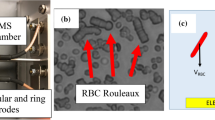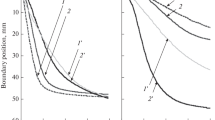Abstract.
An erythrocytes sedimentation rate (ESR) measures how fast a blood sample sediments along a test tube in one hour in a clinical laboratory. Since elevated level of ESR is associated with inflammatory diseases, ESR is one of the routine hematology test in a clinical laboratory. In this paper, the physics of erythrocyte (RBC) sedimentation rate as well as the dynamics of the RBC is explored by modeling the dynamics of the cells as the motion of Brownian particle moving in a viscous medium. The viscous friction of blood \( \gamma\) is considered to decrease as the temperature of the medium increases. The results obtained in this work show that the ESR increases as the number of red blood cells (that bind together in the sedimentation process) steps up. The room temperature also affects the sedimentation rate. As the room temperature rises up, the ESR steps up. Furthermore the dynamics of the RBC along a Westergren pipet that is held in an upright position is explored. The exact analytic result depicts that the velocity of cells increases as the number of cells that form rouleaux steps up. Since our study is performed by considering physiological parameters, the results obtained in this work not only can be justified experimentally but also helps to understand most hematological experiments that are conducted in vitro.
Graphical abstract

Similar content being viewed by others
References
O. Baskurt, B. Neu, H.J. Meiselman, Red Blood Cell Aggregation (CRC Press, 2011) https://doi.org/10.1201/b11221
Alan H.B. Wu, Tietz Clinical Guide to Laboratory Tests (Elsevier Health Sciences, 2006)
S.E. Bedell, B.T. Bush, Am. J. Med. 78, 1001 (1985)
D. Davalos, K. Akassoglo, Semin. Immunopathol. 34, 43 (2012)
G.C. Sharma, M. Jain, R.N. Saral, Comput. Biol. Med. 26, 1 (1996)
J. Vanterler da C. Sousa, E. Capelas de Oliveira, L.A. Magna, AIMS Math. 4, 692 (2017)
J. Vanterler da C. Sousa, Magun N.N. dos Santos, L.A. Magna, E. Capelas de Oliveira, Comput. Appl. Math. 37, 6903 (2018)
T. Tabuchi, H. Tominaga, N. Tatsuni, Southeast Asian J. Trop. Med. 33, 151 (2002)
H.A. Kramer, Physica 7, 284 (1940)
M.A. Taye, S. Duki, Eur. Phys. J. B 88, 322 (2015)
M.A. Taye, W. Sung, EPL 90, 3008 (2010)
M.A. Taye, Phys. Rev. E 82, 021111 (2010)
C.W. Gardiner, Handbook of Stochastic Methods for Physics, Chemistry and the Natural Sciences (Springer, Berlin, 1984)
O. Reynolds, Philos. Trans. R. Soc. London 177, 157 (1886)
E. Bianconi, A. Piovesan, F. Facchin, A. Beraudi, R. Casadei, F. Frabetti, L. Vitale, M.C. Pelleri, S. Tassani, Ann. Human Biol. 40, 463 (2013)
S.R. Hillman, K.A. Ault, H.M. Rinder, Hematology in Clinical Practice: A Guide to Diagnosis and Management (McGraw-Hill Professional, 2005)
A.A. D'Alessandro, Blood Transfus. 15, 182 (2017)
R.E. Klabunde, Cardiovascular Physiology Concepts (Lippincott Williams and Wilkins, 2005)
M.A. Taye, Phys. Rev. E 94, 032111 (2016)
W. Yin, Z. Xu, J. Sheng, X. **e, C. Zhang, Exp. Ther. Med. 14, 1909 (2017)
M.A. Taye, M. Bekele, Eur. Phys. J. B 38, 457 (2004)
Author information
Authors and Affiliations
Corresponding author
Additional information
Publisher's Note
The EPJ Publishers remain neutral with regard to jurisdictional claims in published maps and institutional affiliations.
Rights and permissions
About this article
Cite this article
Taye, M.A. Sedimentation rate of erythrocyte from physics prospective. Eur. Phys. J. E 43, 19 (2020). https://doi.org/10.1140/epje/i2020-11943-2
Received:
Accepted:
Published:
DOI: https://doi.org/10.1140/epje/i2020-11943-2




